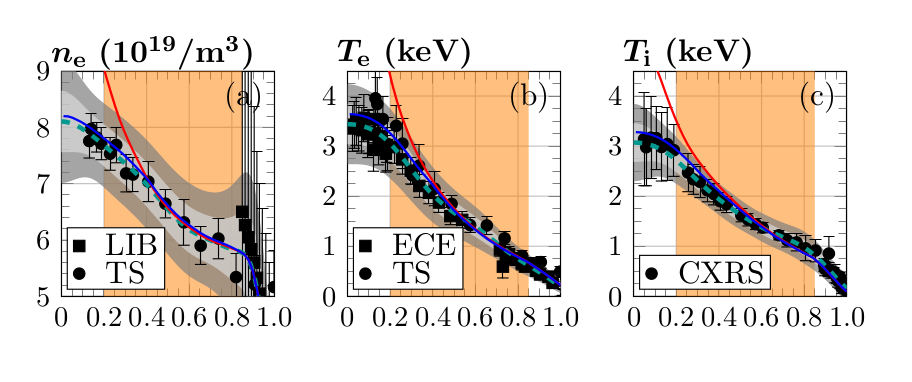Flux-driven transport modelling of ASDEX Upgrade discharges with the quasilinear gyrokinetic code QuaLiKiz
For future nuclear fusion reactors such as tokamaks, the current material of choice for plasma-facing components is the refractory metal tungsten (W). However for the economical exploitation of nuclear fusion, accumulation of W and other heavy impurities in the plasma centre has to be avoided. Heavy impurity transport is often dominated by neoclassical effects and thus determined by main ion temperature and density profiles. Consequently, integrated modelling of main ion heat and particle transport is a vital prerequisite for accurate W impurity transport simulations.
For the first time, the quasilinear gyrokinetic code QuaLiKiz is applied for successful predictions of core main ion density and temperature profiles in the turbulence dominated region of the ASDEX Upgrade tokamak. Coupled to the integrated modelling suite JETTO, plasma profiles predicted in two different phases of discharge #31115 deviate from experimental observations by around 6% only.
To achieve this excellent agreement between simulations and experiment, thorough analysis and careful interpretation of experimental measurements is shown to be crucial for prescribing physically sound simulation conditions. Particle and heat transport predicted is found particularly sensitive to the ion to electron temperature ratio prescribed at the simulation boundary, as well as to the globally assumed effective charge.
Turbulent and neoclassical contributions are insufficient in describing experimental fluxes inside the q=1 surface due to the occurrence of magnetohydrodynamic (MHD) modes in ASDEX Upgrade discharge #31115. The impact of MHD activity on central transport is mimicked by prescribing further transport coefficients, estimated from the difference between effective and predicted central transport.
Trace W impurity transport simulations are carried out in the same discharge using the code NEO for the calculation of neoclassical contributions under consideration of poloidal asymmetries of the W density distribution. Neoclassical W transport alone is found to be insufficient in preventing central W accumulation, regardless of the effect of central MHD activity on main plasma profiles. Reproduction of hollow W density profiles measured experimentally is achieved only when assuming the direct impact of a saturated (m, n) = (1, 1) MHD mode on heavy impurity transport.

